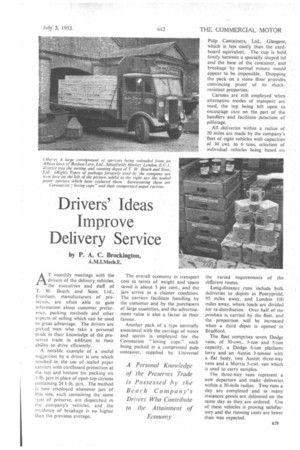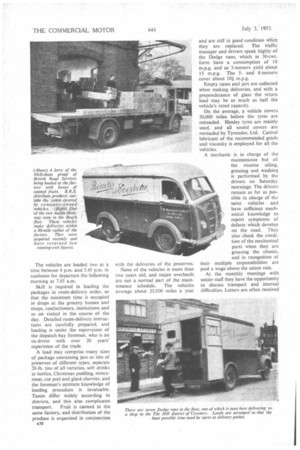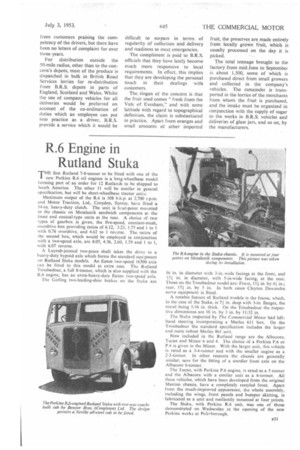Drivers' Ideas Improve Delivery Service
Page 63

Page 64

Page 65

If you've noticed an error in this article please click here to report it so we can fix it.
by P. A. C. Brockington,
AT monthly meetings with the drivers of the delivery vehicles, the executives and staff of T. W. Beach and Sons, Ltd., Evesham, manufacturers of preserves, are often able to gain information about customer preference, packing methods and other aspects of selling which can be used to great advantage. The drivers are picked men who take a personal pride in their knowledge of the preserves trade in addition to their ability to drive efficiently.
A notable example of a useful suggestion by a driver is one which resulted in the use of sealed paper carriers with cardboard protection at the top and bottom for packing six 1-lb. jars in place of open-top cartons containing 24 1-1b. jars. The method ii now employed whenever jars of this size, each containing the same lypz of preserve, are dispatched in the company's vehicles, and the incidence of breakage is no higher than the previous average. The overall economy in transport cost in terms of weight and space saved is about 5 per cent., and the jars arrive in a cleaner condition. The carriers facilitate handling by the customer and by the purchasers of large quantities, and the advertisement value is also a factor in their favour.
Another pack of a type normally associated with the carriage of wines and spirits is employed for the Coronation "loving cups," each being packed in a compressed pulp container, supplied by Universal Pulp Containers, Ltd., Glasgow,. which is less costly than the cardboard equivalent. The cup is held firmly between a specially shaped lid and the base of the container, and breakage by normal misuse would appear to be impossible. Dropping the pack on a stone floor provides convincing proof of its shockresistant properties.
Cartons are still employed when alternative modes of transport arc used, the top being left open to encourage care on the part of the handlers and facilitate iietection of pilferage.
All deliveries within a radius of 50 miles are made by the company's 'fleet of eight vehicles with capacities of 30 cwt. to 6 tons, selection of individual vehicles being based on the varied requirements of the different routes.
Long-distance runs include bulk deliveries to depots in Pontypridd, 95 miles away, and London 100 miles away, where loads are divided for re-distribution. Over half of the produce is carried by the fleet, and the proportion will be increased when a third depot is opened in Bradford.
The fleet comprises seven Dodge vans, of 30-cwt., 3-ton and -5-ton capacity, a Dodge 6-ton platform lorry and an Austin 3-tonner with a flat body, two Austin three-way vans and a Morris 5-cwt. van which is used to carry samples.
The three-way vans represent a new departure and make deliveries within a 30-mile radius. Two runs a day are completed and in many instances goods are delivered on the same day as they are ordered. Use of these vehicles is proving satisfactory and the running costs are lower than was expected. The vehicles are loaded two at a time between 4 p.m. and 5.45 p.m. in readiness for departure the following morning at 7.45 a.m.
Skill is required in loading the packages in route-delivery order, so that the minimum time is occupied in drops at the grocery houses and shops, confectioners, institutions and so on visited in the course of the day. Detailed route-delivery instructions are carefully prepared, and loading is under the supervision of the dispatch-bay foreman, who is an ex-driver with over 20 years' experience of the trade.
A load may comprise many sizes of package containing jars or tins of preserves of different types, separate 28-1b. tins of all varieties, soft drinks in bottles, Christmas pudding, mincemeat, cut peel and glace cherries, and the foreman's intimate knowledge of loading procedure is invaluable. Tastes differ widely according to districts, and this also complicates transport. Fruit is canned in the same factory, and distribution of the produce is organized in conjunction a30 with the deliveries of the preserves.
None of the vehicles is more than two years old, and major overhauls are not a normal part of the maintenance schedule. The vehicles average about 25,000 miles a year and are still in good condition when they are replaced. The traffic manager and drivers speak highly of the Dodge vans, which in 30-cwt. form have a consumption of 18 m.p.g. and as 3-tonners yield about 15 m.p.g. The 5and 6-tonners cover about 10f m.p.g.
Empty cases and jars are collected when making deliveries, and with a preponderance of glass thereturn load may be as much as half the vehicle's rated capacity.
On the average, a vehicle covers 50,000 miles before the tyres are retreaded. Henley tyres are mainly used, and all sound covers are retreaded by Tyresoles, Ltd. Castrol lubricant of the recommended grade and viscosity is employed for all the vehicles.
A mechanic is in charge of the maintenance but all the routine oiling, greasing and washing is performed by the .drivers on Saturday mornings. The drivers remain as far as possible in charge of the same vehicles and have sufficient mechanical knowledge to report symptoms of defects which develop on the road. They also check the condition of the mechanical parts when they are greasing the chassis, and in recognition of their multiple responsibilities are paid a wage above the union rate.
At the monthly meetings with senior staff they have the opportunity to discuss transport and internal difficulties. Letters are often received
from customers praising the competency of the drivers, but there have been no letters of complaint for over three years.
For distribution outside the 50-mile radius, other than to the concern's depots, most of the produce is dispatched in bulk in British Road Services lorries for re-distribution from B.R.S. depots in parts of England, Scotland and Wales. Whilst the use of company vehicles for all deliveries would be preferred on account of the co-ordination of duties which an employee can put into practice as a driver, B.R.S. provide a service which it would be
difficult to surpass in . terms of regularity of collection and delivery and readiness to meet emergencies.
The compliment is paid to B.R.S. officials that they have lately become much more responsive to local requirements. In effect, this implies that they are developing the personal touch in their dealings with customers.
The.slogan of the concern is that the fruit used comes " fresh from the Vale of Evesham," and with some latitude with regard to topographical definition, the claim is substantiated in practice. Apart from oranges and small amounts of other imported fruit, the preserves are made entirely from locally grown fruit, which is usually processed on the day it is picked.
The total tonnage brought to the factory from mid-June to September is about 1,500, some of which is purchased direct from small growers and collected in the company's vehicles. The remainder is transported in the lorries of the merchants from whom the fruit is purchased, and the intake must be organized in conjunction with the supply of sugar to the works in B.R.S. vehicles and deliveries of glass jars, and so on, by the manufacturers.




























































































































































